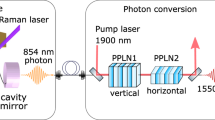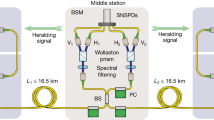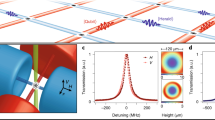Abstract
A quantum internet that connects remote quantum processors1,2 should enable a number of revolutionary applications such as distributed quantum computing. Its realization will rely on entanglement of remote quantum memories over long distances. Despite enormous progress3,4,5,6,7,8,9,10,11,12, at present the maximal physical separation achieved between two nodes is 1.3 kilometres10, and challenges for longer distances remain. Here we demonstrate entanglement of two atomic ensembles in one laboratory via photon transmission through city-scale optical fibres. The atomic ensembles function as quantum memories that store quantum states. We use cavity enhancement to efficiently create atom–photon entanglement13,14,15 and we use quantum frequency conversion16 to shift the atomic wavelength to telecommunications wavelengths. We realize entanglement over 22 kilometres of field-deployed fibres via two-photon interference17,18 and entanglement over 50 kilometres of coiled fibres via single-photon interference19. Our experiment could be extended to nodes physically separated by similar distances, which would thus form a functional segment of the atomic quantum network, paving the way towards establishing atomic entanglement over many nodes and over much longer distances.
This is a preview of subscription content, access via your institution
Access options
Access Nature and 54 other Nature Portfolio journals
Get Nature+, our best-value online-access subscription
$29.99 / 30 days
cancel any time
Subscribe to this journal
Receive 51 print issues and online access
$199.00 per year
only $3.90 per issue
Buy this article
- Purchase on Springer Link
- Instant access to full article PDF
Prices may be subject to local taxes which are calculated during checkout






Similar content being viewed by others
Data availability
The data that support the plots within this paper and other findings of this study are available from the corresponding author upon reasonable request.
References
Kimble, H. J. The quantum internet. Nature 453, 1023–1030 (2008).
Wehner, S., Elkouss, D. & Hanson, R. Quantum internet: a vision for the road ahead. Science 362, eaam9288 (2018).
Julsgaard, B., Kozhekin, A. & Polzik, E. S. Experimental long-lived entanglement of two macroscopic objects. Nature 413, 400–403 (2001).
Chou, C. W. et al. Measurement-induced entanglement for excitation stored in remote atomic ensembles. Nature 438, 828–832 (2005).
Moehring, D. L. et al. Entanglement of single-atom quantum bits at a distance. Nature 449, 68–71 (2007).
Chou, C.-W. et al. Functional quantum nodes for entanglement distribution over scalable quantum networks. Science 316, 1316–1320 (2007).
Yuan, Z.-S. et al. Experimental demonstration of a BDCZ quantum repeater node. Nature 454, 1098–1101 (2008).
Hofmann, J. et al. Heralded entanglement between widely separated atoms. Science 337, 72–75 (2012).
Bernien, H. et al. Heralded entanglement between solid-state qubits separated by three metres. Nature 497, 86–90 (2013).
Hensen, B. et al. Loophole-free Bell inequality violation using electron spins separated by 1.3 kilometres. Nature 526, 682–686 (2015).
Delteil, A. et al. Generation of heralded entanglement between distant hole spins. Nat. Phys. 12, 218–223 (2016).
Humphreys, P. C. et al. Deterministic delivery of remote entanglement on a quantum network. Nature 558, 268–273 (2018).
Simon, J., Tanji, H., Thompson, J. K. & Vuletić, V. Interfacing collective atomic excitations and single photons. Phys. Rev. Lett. 98, 183601 (2007).
Bao, X.-H. et al. Efficient and long-lived quantum memory with cold atoms inside a ring cavity. Nat. Phys. 8, 517–521 (2012).
Yang, S.-J. et al. Highly retrievable spin-wave–photon entanglement source. Phys. Rev. Lett. 114, 210501 (2015).
Kumar, P. Quantum frequency conversion. Opt. Lett. 15, 1476–1478 (1990).
Simon, C. & Irvine, W. T. M. Robust long-distance entanglement and a loophole-free Bell test with ions and photons. Phys. Rev. Lett. 91, 110405 (2003).
Zhao, B., Chen, Z.-B., Chen, Y.-A., Schmiedmayer, J. & Pan, J.-W. Robust creation of entanglement between remote memory qubits. Phys. Rev. Lett. 98, 240502 (2007).
Duan, L.-M., Lukin, M. D., Cirac, J. I. & Zoller, P. Long-distance quantum communication with atomic ensembles and linear optics. Nature 414, 413–418 (2001).
Yuan, Z.-S. et al. Entangled photons and quantum communication. Phys. Rep. 497, 1–40 (2010).
Inagaki, T., Matsuda, N., Tadanaga, O., Asobe, M. & Takesue, H. Entanglement distribution over 300 km of fiber. Opt. Express 21, 23241–23249 (2013).
Yin, J. et al. Satellite-based entanglement distribution over 1200 kilometers. Science 356, 1140–1144 (2017).
Sangouard, N., Simon, C., de Riedmatten, H. & Gisin, N. Quantum repeaters based on atomic ensembles and linear optics. Rev. Mod. Phys. 83, 33–80 (2011).
Gottesman, D., Jennewein, T. & Croke, S. Longer-baseline telescopes using quantum repeaters. Phys. Rev. Lett. 109, 070503 (2012).
Kómár, P. et al. A quantum network of clocks. Nat. Phys. 10, 582–587 (2014).
Tittel, W. et al. Photon-echo quantum memory in solid state systems. Laser Photon. Rev. 4, 244–267 (2010).
Duan, L.-M. & Monroe, C. Quantum networks with trapped ions. Rev. Mod. Phys. 82, 1209–1224 (2010).
Reiserer, A. & Rempe, G. Cavity-based quantum networks with single atoms and optical photons. Rev. Mod. Phys. 87, 1379–1418 (2015).
Aharonovich, I., Englund, D. & Toth, M. Solid-state single-photon emitters. Nat. Photon. 10, 631–641 (2016).
Briegel, H.-J., Dür, W., Cirac, J. I. & Zoller, P. Quantum repeaters: the role of imperfect local operations in quantum communication. Phys. Rev. Lett. 81, 5932–5935 (1998).
Jing, B. et al. Entanglement of three quantum memories via interference of three single photons. Nat. Photon. 13, 210–213 (2019).
Radnaev, A. G. et al. A quantum memory with telecom-wavelength conversion. Nat. Phys. 6, 894–899 (2010).
De Greve, K. et al. Quantum-dot spin–photon entanglement via frequency downconversion to telecom wavelength. Nature 491, 421–425 (2012).
Maring, N. et al. Photonic quantum state transfer between a cold atomic gas and a crystal. Nature 551, 485–488 (2017).
Bock, M. et al. High-fidelity entanglement between a trapped ion and a telecom photon via quantum frequency conversion. Nat. Commun. 9, 1998 (2018).
Ikuta, R. et al. Polarization insensitive frequency conversion for an atom–photon entanglement distribution via a telecom network. Nat. Commun. 9, 1997 (2018).
Walker, T. et al. Long-distance single photon transmission from a trapped ion via quantum frequency conversion. Phys. Rev. Lett. 120, 203601 (2018).
Dréau, A., Tcheborateva, A., Mahdaoui, A. E., Bonato, C. & Hanson, R. Quantum frequency conversion of single photons from a nitrogen-vacancy center in diamond to telecommunication wavelengths. Phys. Rev. Appl. 9, 064031 (2018).
Farrera, P., Heinze, G. & de Riedmatten, H. Entanglement between a photonic time-bin qubit and a collective atomic spin excitation. Phys. Rev. Lett. 120, 100501 (2018).
Jiang, Y., Rui, J., Bao, X.-H. & Pan, J.-W. Dynamical zeroing of spin-wave momentum to suppress motional dephasing in an atomic-ensemble quantum memory. Phys. Rev. A 93, 063819 (2016).
Ma, X.-s. et al. Experimental delayed-choice entanglement swapping. Nat. Phys. 8, 479–484 (2012).
Gühne, O. & Tóth, G. Entanglement detection. Phys. Rep. 474, 1–75 (2009).
Minář, J., De Riedmatten, H., Simon, C., Zbinden, H. & Gisin, N. Phase-noise measurements in long-fiber interferometers for quantum-repeater applications. Phys. Rev. A 77, 052325 (2008).
Yang, S.-J., Wang, X.-J., Bao, X.-H. & Pan, J.-W. An efficient quantum light–matter interface with sub-second lifetime. Nat. Photon. 10, 381–384 (2016).
Li, L., Dudin, Y. O. & Kuzmich, A. Entanglement between light and an optical atomic excitation. Nature 498, 466–469 (2013).
Li, J. et al. Hong-Ou-Mandel interference between two deterministic collective excitations in an atomic ensemble. Phys. Rev. Lett. 117, 180501 (2016).
Collins, O. A., Jenkins, S. D., Kuzmich, A. & Kennedy, T. A. B. Multiplexed memory-insensitive quantum repeaters. Phys. Rev. Lett. 98, 060502 (2007).
Pu, Y.-F. et al. Experimental realization of a multiplexed quantum memory with 225 individually accessible memory cells. Nat. Commun. 8, 15359 (2017).
Tian, L. et al. Spatial multiplexing of atom-photon entanglement sources using feedforward control and switching networks. Phys. Rev. Lett. 119, 130505 (2017).
Parniak, M. et al. Wavevector multiplexed atomic quantum memory via spatially-resolved single-photon detection. Nat. Commun. 8, 2140 (2017).
Bar-Gill, N., Pham, L., Jarmola, A., Budker, D. & Walsworth, R. Solid-state electronic spin coherence time approaching one second. Nat. Commun. 4, 1743 (2013).
Acknowledgements
This work was supported by the National Key R&D Program of China (2017YFA0303902, 2018YFB0504300, 2017YFA0304000), the Anhui Initiative in Quantum Information Technologies, the National Natural Science Foundation of China and the Chinese Academy of Sciences. We thank QuantumCTek for providing the field-deployed fibres.
Author information
Authors and Affiliations
Contributions
X.-H.B. and J.-W.P. conceived the research. Q.Z., X.-H.B. and J.-W.P. designed the experiment. Y.Y., X.-Y.L., B.J., P.-F.S., R.-Z.F., C.-W.Y. and X.-H.B. carried out the experiment with assistance from all other authors. F.M., M.-Y.Z., X.-P.X. and Q.Z. built the QFC module. W.-J.Z., L.-X.Y. and Z.W. fabricated the superconducting nanowire single-photon detectors. Y.Y., Q.Z., X.-H.B. and J.-W.P. analysed the data and wrote the paper with input from all other authors.
Corresponding authors
Ethics declarations
Competing interests
The authors declare no competing interests.
Additional information
Publisher’s note Springer Nature remains neutral with regard to jurisdictional claims in published maps and institutional affiliations.
Supplementary information
Supplementary Information
This file contains the following sections: I. General information of experimental setups; II. Phase stabilization; III. Lasers in outdoor application; IV. Analysis on experimental imperfections; V. Entanglement evaluation of Fock state entanglement; and additional references.
Rights and permissions
About this article
Cite this article
Yu, Y., Ma, F., Luo, XY. et al. Entanglement of two quantum memories via fibres over dozens of kilometres. Nature 578, 240–245 (2020). https://doi.org/10.1038/s41586-020-1976-7
Received:
Accepted:
Published:
Issue Date:
DOI: https://doi.org/10.1038/s41586-020-1976-7
This article is cited by
-
Hong-Ou-Mandel interference of single-photon-level pulses stored in independent room-temperature quantum memories
npj Quantum Information (2024)
-
Non-classical microwave–optical photon pair generation with a chip-scale transducer
Nature Physics (2024)
-
All-fiber device for single-photon detection
PhotoniX (2023)
-
Field programmable spin arrays for scalable quantum repeaters
Nature Communications (2023)
-
Progress in quantum teleportation
Nature Reviews Physics (2023)
Comments
By submitting a comment you agree to abide by our Terms and Community Guidelines. If you find something abusive or that does not comply with our terms or guidelines please flag it as inappropriate.



